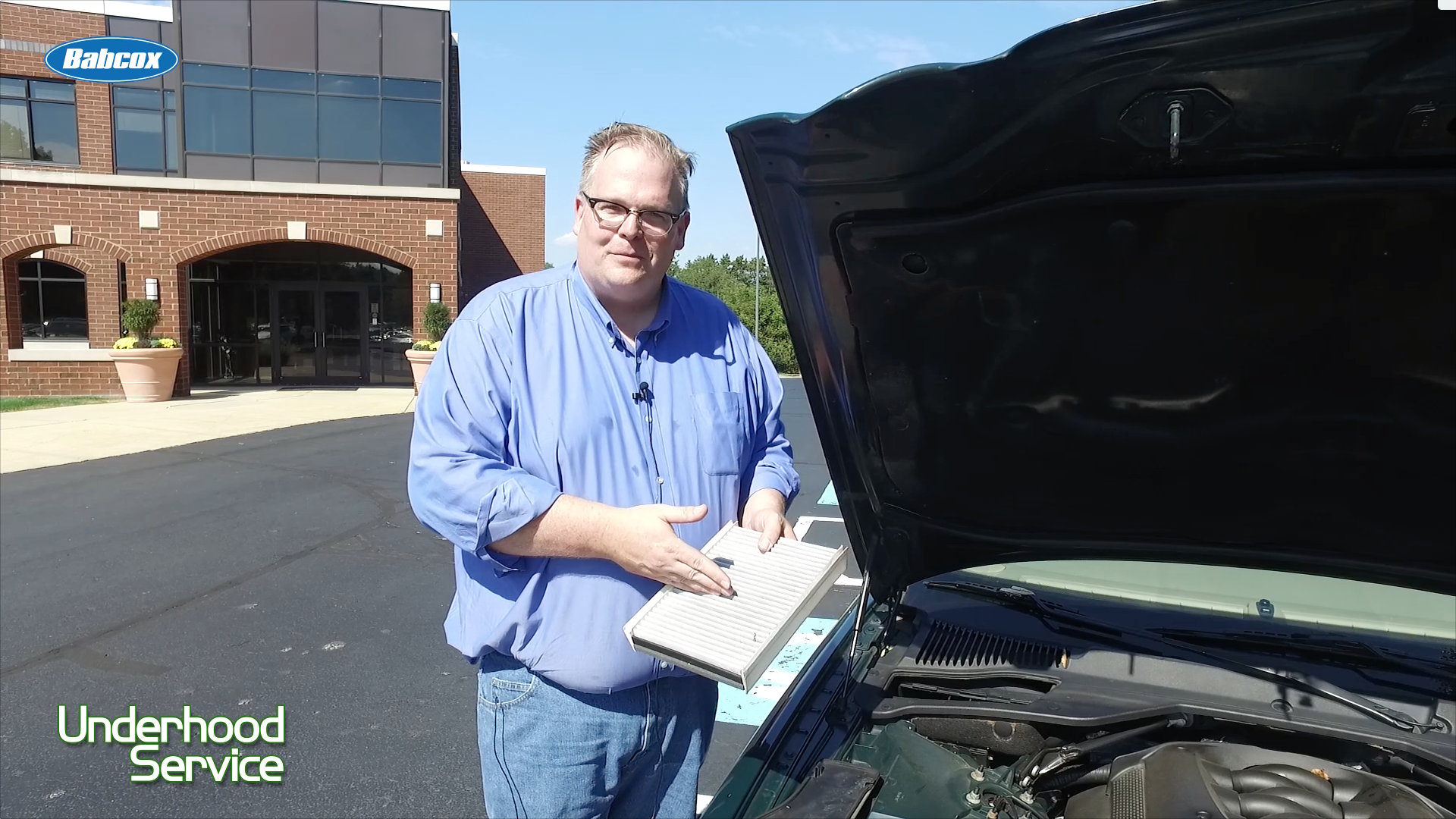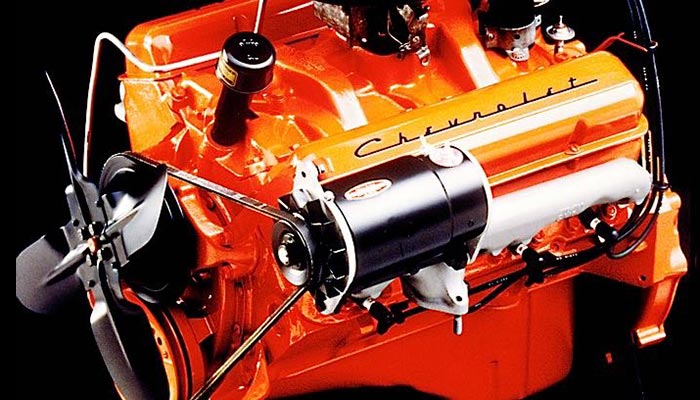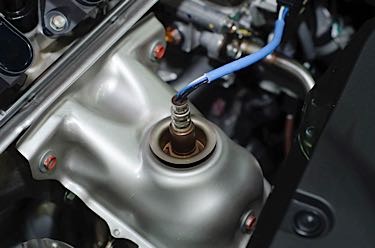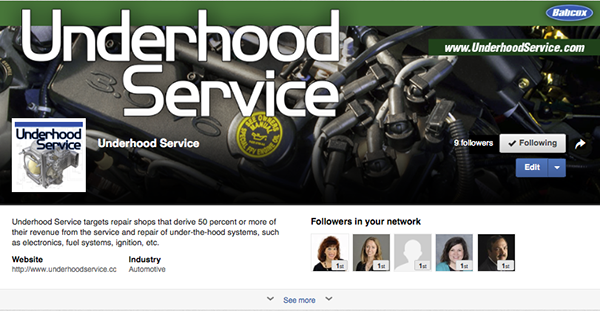Police cars, ambulances, taxis, parcel delivery trucks and even pizza delivery vehicles can chew up brake pads and rotors almost as fast as any race car. Hard use combined with frequent, sudden stops makes the brakes run hot, and when brake temperatures shoot up, the life of the pads and rotors plummets. For every increase of 100 degrees over the normal operating temperature, brake wear doubles. And the longer the brakes stay hot, the more they wear.
Because of this, it is not unusual for police cars, taxis and pizza delivery vehicles to go through a set of pads and rotors in as little as 6,000 to 12,000 miles. Most consumers would scream bloody murder if they had to replace their brakes that often. But with these kind of applications, it’s just an ongoing cost of keeping the vehicle on the road.
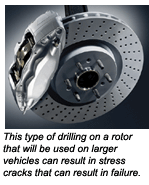 TIME IS MONEY
TIME IS MONEY
Brake technology has improved a great deal in recent years, and many friction materials are providing longer service life than ever before —even in severe-duty fleet applications. Even so, rotors are still wearing out, warping and cracking from the heat and hard use. Many fleets say they have to replace the rotors when they change the pads because the original rotors are shot. That adds considerable cost to every repair, and does nothing to improve the longevity of the brakes or to improve the vehicle’s braking performance.
Consequently, some fleets are trying a different approach. Instead of always replacing the stock OEM rotors with the same, they are buying some type of premium grade rotor for their vehicles. These include slotted “performance” rotors that run cooler, shed water quicker, keep the pads cleaner and provide extra bite when the brakes are applied, and/or cryogenically-treated rotors that run cooler, last longer and resist warping and cracking much better than stock rotors.
A stock OEM rotor for a Ford Crown Victoria police car typically sells for around $120. Aftermarket performance rotors and cryogenically-treated rotors, by comparison, may cost $65 to $160 depending on the source. So by shopping around, a better replacement rotor can usually be bought for the same or even less than an OEM stock replacement rotor.
SLOTTED ROTORS
Slotted rotors are often used in racing applications to deliver maximum braking performance. A slotted rotor will usually have four to six shallow grooves machined into both faces of the rotor. The slots may be straight or curved, and radiate out at an angle from the center. The slots wipe the surface of the pads when the brakes are applied to expel brake dust and gas away from the brakes. The slots also improve wet weather braking by preventing road splash from getting between the pads and rotors. Wet pads rubbing against wet rotors can sometimes hydroplane, causing the pads to slip rather than grip.
Most of the companies that make slotted rotors recommend them for severe-duty braking applications as well as racing. This includes using them on police cars, taxis, vehicles used for towing, larger trucks and SUVs, and almost any vehicle that has a history of eating brake pads and rotors.
Street performance enthusiasts also like slotted (and drilled) rotors because the rotors look cool behind their custom alloy wheels. But the real reason for using this type of product is to achieve better braking, reduce the risk of heat face and extend rotor life. One thing to keep in mind about slotted rotors is that they can produce a slight hum or whirring noise when braking hard. This is normal and results from the action of the slots sliding under the pads. The rotors may also “feel” more aggressive than stock rotors because of the increased initial bite that occurs as a result of the slots keeping the pads cleaner.
DRILLED ROTORS
Before slotted rotors came into use, some racers drilled small holes through the faces of their rotors to improve cooling. The holes did improve cooling and helped vent gases from hot pads during hard braking, but the holes also creased stress risers in the rotors that often lead to cracking and rotor failure. To reduce the stress risers, chamfers were added to the holes. This helped somewhat, but better solutions were developed as time went on. Holes that were cast into the rotor proved to work better than drilled holes. Casting holes allows the grain structure of the metal to form naturally around the holes, whereas drilling through the rotor cuts through the grain structure and increases the risk of cracking.
Changing the shape of the hole chamfers also makes a difference. A drilled rotor with no chamfers or a sharp edged angle chamfer tends to act like a cheese grater when the brakes are applied. The edges scrape across the pads. This increases friction for a better bite and helps clean the pads, but it can also increase pad wear and cause the pads to wear out faster. By rounding the edges of the chamber so there are no sharp edges, the cheese grater effect is eliminated. Now the holes can provide venting and cooling without contributing to wear.
Some rotor suppliers also use holes that do not extend all the way through the rotor, or are just a series of shallow dimples machined into the rotor surface. The claimed advantage with this approach is that it provides the same venting effect, but with much with less risk of rotor cracking.
Many companies who sell drilled rotors only recommend them for normal street driving, not severe use or racing. This type of product is better suited for applications where the vehicle owner wants to show off his rotors rather than push them to the limit.
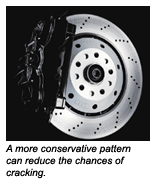 SLOTTED & DRILLED ROTORS, & VENTED ROTORS
SLOTTED & DRILLED ROTORS, & VENTED ROTORS
Some say rotors that use both holes and slots provide the best of both worlds: the cleaning action of slots and the cooling action provided by the holes. Others say rotors with slots alone provide most of the same performance benefits without the risk of cracking associated with cross-drilled rotors.
Other design features of a rotor are just as important. All vented rotors have cooling ribs cast between the rotor surfaces. The ribs act like fan blades to pump air through the rotor to dissipate heat. Vehicle manufacturers currently use more than 70 different cooling rib configurations in their vented rotors. Some ribs are straight, some are curved and some are even segmented. Some ribs are evenly spaced while others are not. Most ribs radiate outward from the center, but others zigzag like a maze. Engineers develop these different rib configurations to “optimize” brake cooling on specific vehicles, and to reduce harmonics that contribute to brake squeal.
The bottom line here is that any replacement rotor you install should cool as good as or better than the original rotor. If you install stock OEM replacement rotor, the rotor should perform exactly the same as before (no better, no worse). But if you replace the original rotor with a cheap rotor to save a few bucks, you may end up with a rotor that doesn’t cool as well as before, runs hot, eats pads and may fail prematurely as a result of warping and/or cracking.
An aftermarket replacement rotor may or may not have the same rib configuration as the OEM rotors. “Premium” aftermarket replacement rotors typically duplicate the OEM design, and provide the same cooling performance — and often cost less than OEM rotors.
On the other hand, many low-priced “economy” rotors do not follow the OEM rib design. This may be done to reduce manufacturing costs or to consolidate rotor applications. The metallurgy of a cheap rotor may also fall short of the same standards used by an OEM rotor supplier or premium aftermarket rotor manufacturer. Consequently, economy rotors may be OK for light use everyday driving, but they won’t stand up or perform like OEM rotors, premium aftermarket rotors or performance rotors.
ROTOR METALLURGY
Brake rotors are made of gray cast iron, and the metallurgical properties of the iron as well as the casting process itself determines the rotor’s strength and hardness, as well as its noise, wear and braking characteristics. The purity of the iron, the alloys that are added to it, the temperature at which the molten metal is poured into the mold, the cooling process and finally the machining process are all variables that must all be carefully controlled to produce a high-quality rotor.
The rate at which the iron cools in the mold is critical and must be closely monitored to achieve the correct tensile strength, hardness and microstructure. Rotors that are yanked from their molds too quickly cool unevenly and often end up with residual internal stresses that later lead to warping and cracking.
When a low quality rotor is installed on a vehicle and is subjected to hard use, high brake temperatures only make the metallurgy worse. The rotor may form hard spots that cause uneven wear, distortion and brake pedal pulsations. Worse yet, the iron may form microscopic cracks that weaken the rotor. As the cracks grow and spread, the rotor may develop cracks that eventually lead to rotor failure and brake failure. That’s the last thing you want to happen on a police car in the middle of a high speed pursuit.
CRYOGENICALLY-TREATED ROTORS
One way to make sure the metallurgy of a rotor is the best it can be is to cryogenically treat the rotor after it has been manufactured. Cryogenic processing involves placing rotors in special refrigeration equipment that takes the parts down to the temperature of liquid nitrogen — minus 300 degrees F below zero! At such extremely cold temperatures, a lot of really “cool” things happen. Atoms stop shaking around and settle down into a more relaxed state. This helps relax residual stresses in the metal for improved fatigue resistance, tensile strength, abrasion resistance and hardness. In steel alloys, it can actually change the microstructure of the metal itself. Cast iron contains more carbon than steel, so the microstructure does not change as dramatically.
Even so, when done properly a cryogenically-treated rotor will run cooler (some claim up to 40% cooler!), last longer (two to four times longer), and resist warping and cracking better than any untreated rotor. The process can be applied to stock OEM rotors, aftermarket rotors, or drilled or slotted rotors, and it treats the part all the way through, not just the surface.
Racers often have engine and chassis parts cryogenically treated to improve their durability so they don’t break during a race. The same process is also used to improve the life of tool bits, gun barrels, razor blades, knives, and even golf clubs and baseball bats.
The science of cryogenics dates back to the 1930s, when the Germans invented it for treating critical parts that went into aircraft engines. It wasn’t until the 1960s, however, that cryogenic processes were developed in this country for treating automotive and industrial parts.
The process is sort of like heat treating in reverse. The temperature of the object being treated is changed to bring about improvements in its crystal structure. Cryogenics requires freezing parts at a controlled rate so they don’t get too cold too quickly and shatter. If you drop a rubber ball in a tank of liquid nitrogen, it will become as brittle as glass, and the ball will shatter if it is dropped on the ground. But if the ball is allowed to warm back up, it will not only bounce the same as before, but bounce longer and better.
Once parts are cooled down to minus 300 degrees below zero, they are cold soaked for a number of hours before they are allowed to gradually warm back up to room temperature. The process is computer controlled, and may take 36 to 74 hours depending on the mass and type of parts being treated.
Suppliers who sell cryogenically-treated rotors say their rotors are the ultimate solution for police cars, taxis and other severe use applications. One recent article in a trade magazine for police fleet managers said many police departments across the country have switched to cryogenic rotors to reduce maintenance costs, down time and brake wear problems. Most of the law enforcement agencies cited in the article report significantly longer rotor life (typically two to three times longer life than standard rotors), fewer complaints about brake fade (thanks to better cooling), fewer brake problems such as warping and pedal pulsations, and longer pad life, too.
Cryogenically-treated rotors may sell for the same, more or even less than OEM stock rotors or other types of aftermarket performance rotors depending on the supplier and quantity ordered. Even if a rotor costs $30 or more than the best price you can find on a standard OEM replacement rotor, the longer service life of a cryogenically-treated rotor should more than offset the price difference. The improved resistance to warping and cracking also means fewer complaints from drivers about pedal pulsations. Improved cooling should also improve driving safety by reducing the heat fade in the brakes.
Those who use cryogenically-treated rotors say they can be resurfaced the same as regular rotors, and used until they wear down to minimum thickness specifications. No change in friction materials is required, though some rotor suppliers recommend using semi-metallic pads for best results.









